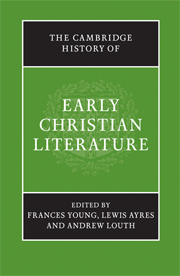Crossref Citations
This Book has been
cited by the following publications. This list is generated based on data provided by Crossref.
2008.
Psalms Through the Centuries.
p.
322.
2009.
An Introduction to Catholicism.
p.
269.
Merrick, James R. A.
2010.
Sola scriptura and the regula fidei: the Reformation scripture principle and early oral tradition in Martin Chemnitz' Examination of the Council of Trent.
Scottish Journal of Theology,
Vol. 63,
Issue. 3,
p.
253.
Bigalke, Ron J.
2011.
The Encyclopedia of Christian Civilization.
Hartog, Paul
2011.
The Encyclopedia of Christian Civilization.
Louth, Andrew
2011.
Holiness and Sanctity in the Early Church.
Studies in Church History,
Vol. 47,
Issue. ,
p.
1.
Hartog, Paul
2011.
The Encyclopedia of Christian Civilization.
Choy, Renie
2012.
Seeking Meaning Behind Epistolary Clichés: Intercessory Prayer Clauses in Christian Letters.
Studies in Church History,
Vol. 48,
Issue. ,
p.
1.
Webster, John
2012.
T. F. Torrance on Scripture.
Scottish Journal of Theology,
Vol. 65,
Issue. 1,
p.
34.
2012.
A Companion to Augustine.
p.
517.
Stenger, Jan
2015.
A Companion to Greek Literature.
p.
126.
Van Wyk, Tanya
and
Van Wyk, Neltjie C.
2017.
Die lewe en werk van Frances Young (1939–) en Dorothee Sölle (1929–2003): ʼn Leksikografiese bydrae tot Reformasie 500.
HTS Teologiese Studies / Theological Studies,
Vol. 73,
Issue. 1,
Miguélez‐Cavero, Laura
and
McGill, Scott
2018.
A Companion to Late Antique Literature.
p.
259.
Curran, John
2018.
A Companion to the City of Rome.
p.
541.
Neil, Bronwen
Costache, Doru
and
Wagner, Kevin
2019.
Dreams, Virtue and Divine Knowledge in Early Christian Egypt.
LaValle Norman, Dawn
2019.
The Aesthetics of Hope in Late Greek Imperial Literature.
Shepard, Jonathan
2019.
The Cambridge History of the Byzantine Empire c.500–1492.





